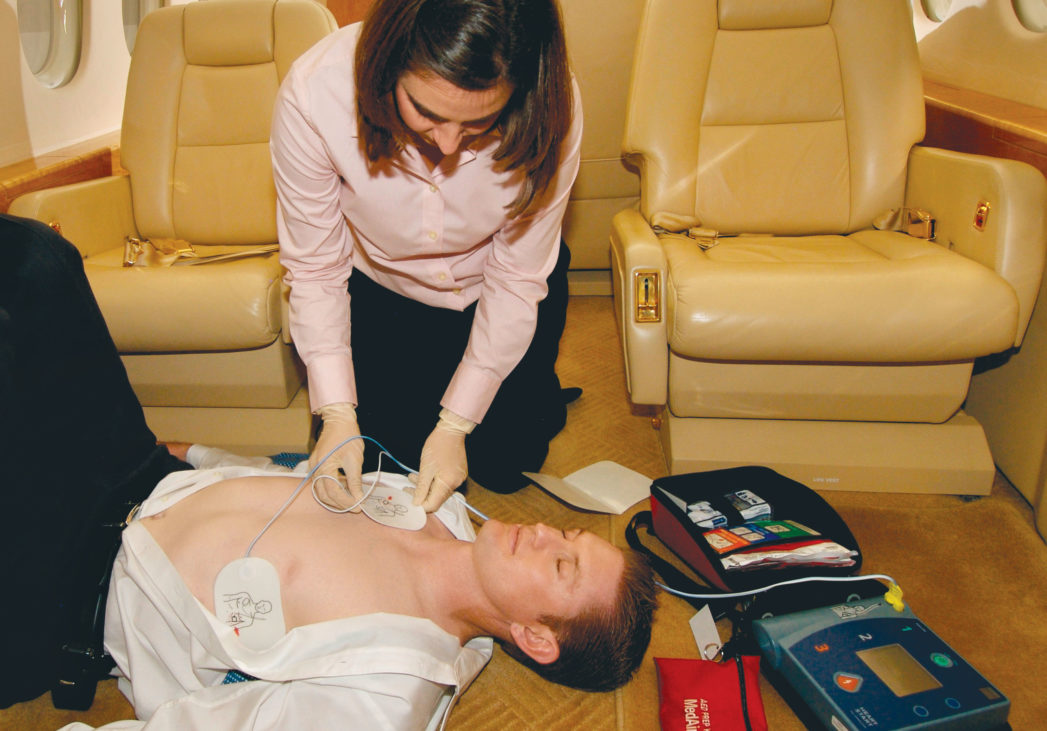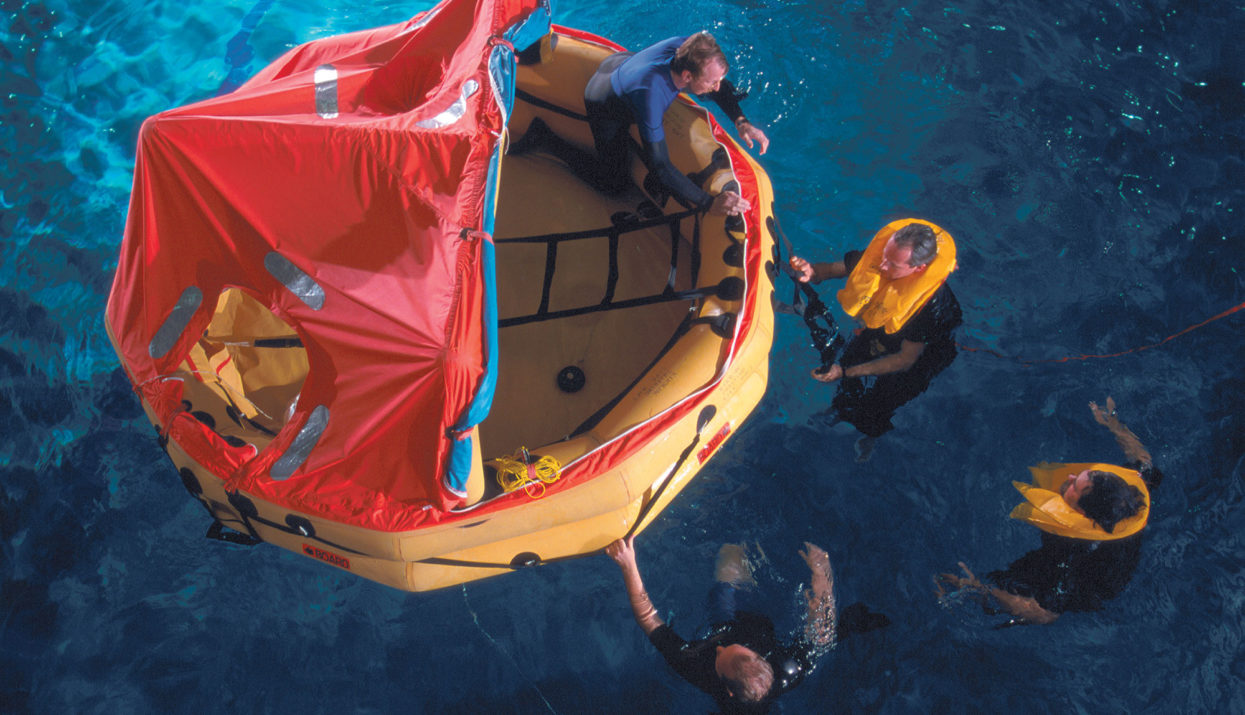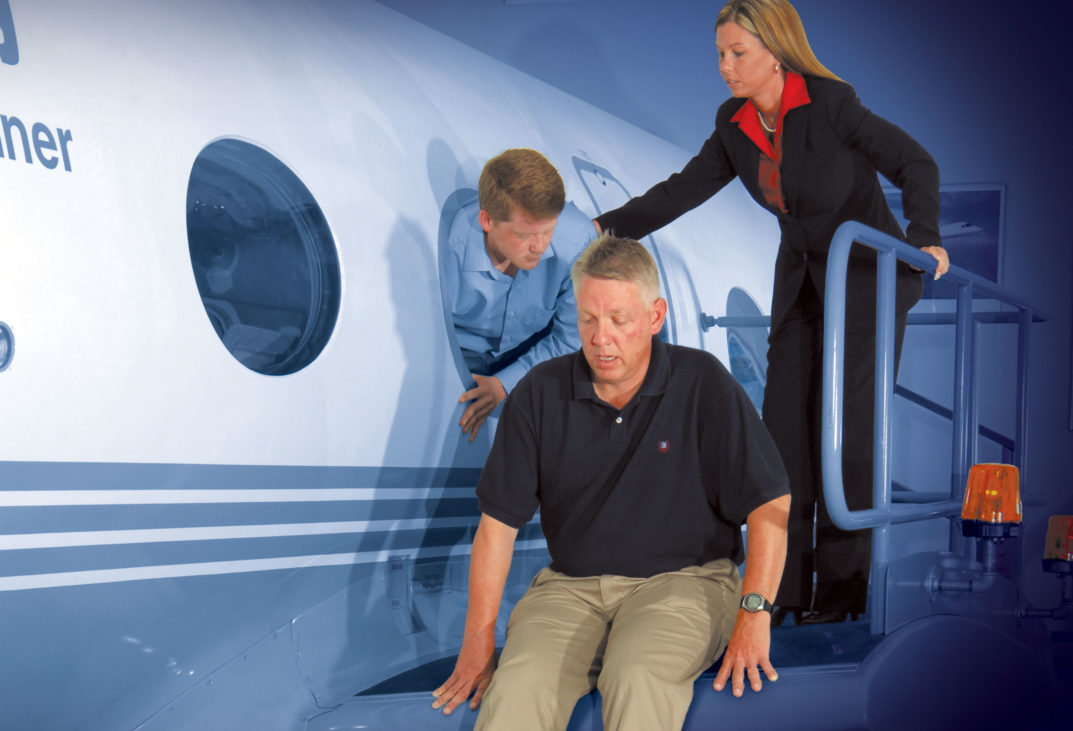
Nov. 30, 2016
How alert are you as a passenger on a flight in a business aircraft? Do you pay attention to the pre-flight safety briefing? Do you become absorbed in work or conversations throughout the flight?
What would you do if your phone or computer overheated and caught fire, and the cabin suddenly filled with smoke? Or a fellow passenger became seriously ill? Would you know where to locate a fire extinguisher or defibrillator, or how to use them? What if the plane crash-landed?

Aircraft passengers need to be in mental “Condition Orange,” advises Louisa Fisher, program manager for cabin safety at FlightSafety International and vice chair of the NBAA Flight Attendants Committee. “Condition Orange means something could happen, but you’re already thinking of your options of what to do.”
Condition Orange is part of a color-coding situational awareness system developed originally for the military and law enforcement by the late Jeff Cooper. In Condition Green, you are relaxed and unaware of what’s around you; for example, iPhone on, earplugs in, focus somewhere far away. Your reaction times to an emergency will be slower, and you are more susceptible to becoming a statistic in a disaster. In Condition Orange, you are more vigilant of your surroundings and have a “what if” plan in your head.
WHY TRAIN YOUR PASSENGERS?
It’s not enough to assume that the flight attendant or flight technician, if one is onboard, will take care of any crisis. Passengers – especially frequent flyers – should be knowledgeable about the safety and medical equipment available and procedures for their use.
Some flight departments put their very important passengers through specialized training such as FlightSafety’s Executive Safe Flight program. Fisher says, at the request of customers, the program was evolved from their general emergency training for pilots. They get up to 10 requests a year, and the class can be conducted at select FlightSafety locations or at the customer’s site.
The class includes hands-on training in how to use extinguishers, portable oxygen bottles and other emergency equipment. Then the group moves to the aircraft they typically fly in, and they learn where the equipment is stowed. They also experience opening doors and overwing exits. In a series of simulated scenarios, the passengers may have to extract a life raft and inflate life vests in the hangar to learn their features.
“Some operators will ask for specific areas such as smoke (using theatrical smoke) or a mask drop, simulating aircraft decompression,” Fisher said. “They’ll even connect the oxygen masks to therapeutic outlets and portable oxygen bottles to get a better understanding of how the devices work.
“There is empowerment in the awareness of where things are and what I would do to help myself and help other passengers and the crew, if need be,” Fisher explains.

A RANGE OF TRAINING OPTIONS
ConocoPhillips, an IS-BAO 3-registered operator (i.e., safety management activities are fully integrated and a positive safety culture is sustained), checks out its top flyers on emergency equipment each year, and the flight attendants train with the pilots annually – one year on joint emergency drills and the next at a professional training facility.
“We like to use simulators so we get the real feel of the aircraft. Pull the windows, get in the raft, the whole works,” says Kristina Bauer-Selten, a ConocoPhillips flight attendant who chairs the Training and Safety Subcommittee of NBAA’s Flight Attendants Committee.
An increasingly popular feature is water egress and sea survival training, replicating a ditching situation. A special aircraft cabin simulator is submerged in a pool, teaching students how to avoid panic, put on and inflate the life preserver, safely exit the aircraft, get to the surface and board the raft. Organizations ranging from FlightSafety to Embry-Riddle Aeronautical University to ProAviation in Canada (where seaplanes and lake landings are more prevalent) now offer water ditching training.
There is empowerment in the awareness of where things are and what I would do to help myself and help other passengers and the crew, if need be.
Bauer-Selten says the company’s executive and shuttle fleet flight attendants are also certified ASHI emergency medical responders, as graduates of the American Safety and Health Institute (ASHI) for first aid, cardiopulmonary resuscitation, automated external defibrillators and other airborne health crises. “It’s emergency training one step further, being able to recognize symptoms such as heart attack and diabetic insulin shock,” she notes. “You can’t always get on the ground as quickly as you would like.”

Some fatalistic frequent flyers assume they wouldn’t survive an aircraft accident, and so can’t be bothered to pay attention to even the basic safety briefing. However, about four of five people live through most crashes. Even so, many of them simply wait passively for directions. In a Condition Orange situation where the pilot and/or flight attendant become incapacitated, having well-trained passengers could mean the difference between life and death.


 International Business Aviation Council Ltd.
International Business Aviation Council Ltd.